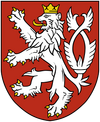| William-George | |
|---|---|

| |
| William-George | |
| Prince-Elector of Oldenburg | |
| Reign | 20th December, 1601 - 3rd July, 1629 |
| Predecessor | George |
| Successor | Catherine |
| King of Bohemia | |
| Reign | 9th September, 1619 - 26th August, 1620/3rd July, 1629 |
| Predecessor | Charles III |
| Successor | Catherine/Charles III |
| Born | 25th November, 1574 Delmenhorst, Electorate of Oldenburg, (now Denmark) |
| Died | 3rd July, 1629 Vienna, Austria |
| Spouse | Sophie of Denmark Elizabeth-Sophia of Wolgast-Heringsdorf |
| Issue | Catherine |
| House | Oldenburg |
| Father | Prince-Elector George of Oldenburg |
| Mother | Anna of Güstrow |
William-George was Prince-Elector of Oldenburg and, briefly, King of Bohemia at the start of the Fifty Years War.
He would spend much of his childhood in and out of the Kiel court of Eric XI, making firm friends with the future Eric XII. He would marry Princess Sophie of Denmark in 1590. Despite numerous pregnancies there were no surviving children and she would die in 1600.
He inherited Oldenburg in 1601 after his father's death, and with it a considerable debt, but his father's policies of dyke construction along the coast started to bring dividends in agricultural production. A reorganisation of the judiciary and the Lutheran church administration sealed his reputation as a competent and thoughtful ruler though he was just as interested in military affairs. His close association with the Danish court gave him insight to Eric XII's army reforms and using his reorganised church began to copy the new techniques in recruitment and supply.
A second marriage, to Countess Elizabeth-Sophia of Wolgast-Heringsdorf, proved equally childless, and in 1616 he would marry for a third time, this time to Catherina of Schwarzburg.
At the start of the Fifty Years War, when the decision was made to invade Bohemia and protect the Protestants there from Austrian attacks, William-George was put in command of the main Schmalkaldic army and invaded through Electoral Saxony, successfully humiliating Christian II at Halle and Dresden and gaining Prague by May 1619. Snubbing Luxembourg claims, the Schmalkaldic leadership urged the Prague Diet to proclaim one of the Electors as the new king and as such William-George was proclaimed 'King of Bohemia' by Diet, now being stripped of all its Catholic members.
His sole heir, Catherine, was born on 3rd January 1620, the same day Austria and Luxembourg concluded their alliance and the war really kicked off in earnest. At the same time William-George was butting up against the limitations of the Bohemian crown; the treasury had effectively disappeared and with so many Catholic lords now excluded from government the ability to collect taxes was severely constrained. Not speaking Czech, his government was soon in the hands of foreigners, which alienated him from his lords. Plans to reform the army in Bohemia remained just words as the lords balked at giving up their rights to raise their own militias. Still he and the army managed to restore calm to the kingdom and given time his rule may have successfully 'bedded in'. However time was not on his side.
Whilst the other commanders found success against the Catholic alliance now threatening the Schmalkaldic Empire, William-George's position looked increasingly dire. By summer 1621 with Polish forces bearing down from the east and Austria unopposed in the south Prague looked vulnerable. Queen Catherina and Princess Catherine were hastily smuggled north, first to Brandenburg and then to Eric XII's court in Copenhagen. William-George attempted one last stand at Psáre before Austria and Poland could join up but to no avail.
He was imprisoned in the hunting lodge at Wolfsau in Vienna, in relative luxury. He would spend seven years in captivity during which time his plight became a rallying call for the Schmalkaldic leadership. He would die on 1629, of a ruptured appendix. Catherine inherited Oldenburg and, according to the Czech nobles maintaining a court in exile in Copenhagen, the crown of Bohemia as well, as empty that title was in the current situation.
| |||||||||||||||||||||||||||||||
| ||||||||||||||||||||


